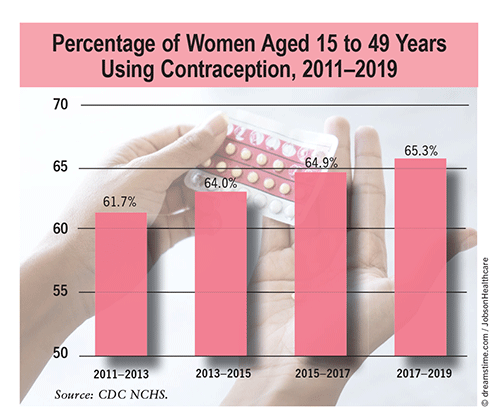US Pharm. 2023;48(9):14.
According to the CDC, advances in contraception and family planning were among the greatest public-health achievements of the 20th century. The use of contraception improves overall health and well-being, reduces maternal mortality, increases female engagement in the workforce, and promotes women’s financial independence. In the United States, approximately 99% of women who have been sexually active report using some form of contraception during their lifetime, with 87.5% using reversible methods (e.g., intrauterine devices, implants).

Use and Methods: The National Center for Health Statistics reported a steady increase in the percentage of women using contraceptives between 2011 and 2019, and current contraceptive use was found to increase with age. For the 2015–2017 time period, the range was 37.2% for women aged 15 to 19 years to 73.7% for those aged 40 to 49 years, and for the 2017–2019 period, the range was 38.7% to 74.8%, respectively. From 2017 to 2019, 69.2% of non-Hispanic white women currently used contraception, compared with 61.4% of non-Hispanic black women and 60.5% of Hispanic women. Use was similar across all education levels (67% to 76%), with no statistically significant differences between 2011 and 2019. Since 2015, female sterilization (tubal ligation) has been the most-used contraceptive method in the U.S., followed by the pill, long-acting reversible contraceptives (LARCs), and male condoms. Currently, female sterilization is most common among women aged 40 to 49 years (39.4%). The pill, LARCs, and condoms are used most by women aged 20 to 29 years (19.5%, 13.1%, and 11.6%, respectively).
Barriers: The American College of Obstetricians and Gynecologists has identified misperceptions (e.g., certain types of contraceptives being abortifacients), exaggerated concerns about the safety of contraceptive methods, and lack of knowledge among women and some healthcare providers as significant barriers to contraceptive use. Out-of-pocket contraceptive costs (including insurance deductibles and copayments) have also been found to limit access nationwide. A number of studies support universal coverage of contraception to reduce unintended pregnancies, abortion rates, and billions of dollars in related government expenditures.
Access: Nearly 1.2 million reproductive-age women are estimated to live in U.S. counties without clinics that offer a full range of contraceptive methods. Women who travel more than 30 minutes to obtain contraception are 2.5 times less likely to use it than women with closer access. To promote reproductive healthcare and improve access, 30 states and the District of Columbia have passed laws allowing pharmacists to provide contraceptive care. Types of prescriptive authority (e.g., standing order, collaborative practice agreement), contraceptive methods, payment for pharmacist services, and training requirements vary from state to state. Also, in July 2023, the FDA approved the first nonprescription daily oral contraceptive, Opill (norgestrel). This OTC product is expected to be available in stores and online in early 2024.
The content contained in this article is for informational purposes only. The content is not intended to be a substitute for professional advice. Reliance on any information provided in this article is solely at your own risk.
To comment on this article, contact rdavidson@uspharmacist.com.






